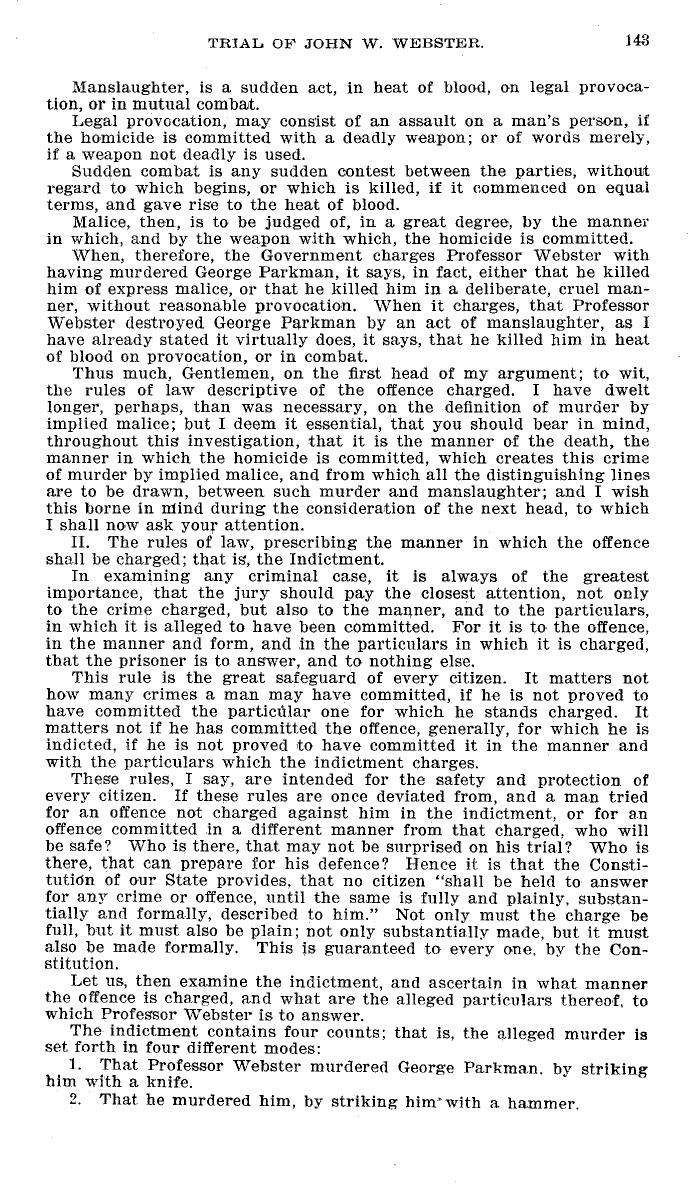|
TRIAL OF JOHN W. WEBSTER. 143
Manslaughter, is a sudden act, in heat of blood, on legal provoca-
tion, or in mutual combat.
Legal provocation, may consist of an assault on a man's person, if
the homicide is committed with a deadly weapon; or of words merely,
if a weapon not deadly is used.
Sudden combat is any sudden contest between the parties, without
regard to which begins, or which is killed, if it commenced on equal
terms, and gave rise to the heat of blood.
Malice, then, is to be judged of, in a great degree, by the manner
in which, and by the weapon with which, the homicide is committed.
When, therefore, the Government charges Professor Webster with
having murdered George Parkman, it says, in fact, either that he killed
him of express malice, or that he killed him in a deliberate, cruel man-
ner, without reasonable provocation. When it charges, that Professor
Webster destroyed George Parkman by an act of manslaughter, as I
have already stated it virtually does, it says, that he killed him in heat
of blood on provocation, or in combat.
Thus much, Gentlemen, on the first head of my argument; to wit,
the rules of law descriptive of the offence charged. I have dwelt
longer, perhaps, than was necessary, on the definition of murder by
implied malice; but I deem it essential, that you should bear in mind,
throughout this investigation, that it is the manner of the death, the
manner in which the homicide is committed, which creates this crime
of murder by implied malice, and from which all the distinguishing lines
are to be drawn, between such murder and manslaughter; and I wish
this borne in Mind during the consideration of the next head, to which
I shall now ask your attention.
II. The rules of law, prescribing the manner in which the offence
shall be charged; that is, the Indictment.
In examining any criminal case, it is always of the greatest
importance, that the jury should pay the closest attention, not only
to the crime charged, but also to the manner, and to the particulars,
in which it is alleged to have been committed. For it is to the offence,
in the manner and form, and in the particulars in which it is charged,
that the prisoner is to answer, and to nothing else.
This rule is the great safeguard of every citizen. It matters not
how many crimes a man may have committed, if he is not proved to
have committed the particular one for which he stands charged. It
matters not if he has committed the offence, generally, for which he is
indicted, if he is not proved to have committed it in the manner and
with the particulars which the indictment charges.
These rules, I say, are intended for the safety and protection of
every citizen. If these rules are once deviated from, and a man tried
for an offence not charged against him in the indictment, or for an
offence committed in a different manner from that charged, who will
be safe? Who is there, that may not be surprised on his trial? Who is
there, that can prepare for his defence? Hence it is that the Consti-
tution of our State provides, that no citizen "shall be held to answer
for any crime or offence, until the same is fully and plainly, substan-
tially and formally, described to him." Not only must the charge be
full, but it must also be plain; not only substantially made, but it must
also be made formally. This is guaranteed to every one, by the Con-
stitution.
Let us, then examine the indictment, and ascertain in what manner
the offence is charged, and what are the alleged particulars thereof, to
which Professor W ebster is to answer.
The indictment contains four counts; that is, the alleged murder is
set forth in four different modes:
7. That Professor Webster murdered George Parkma.n. by striking
him with a knife.
2. That he murdered him, by striking him°with a hammer.
|

